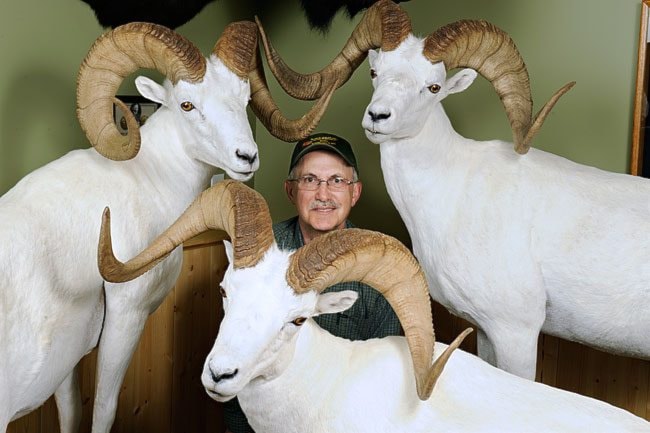When Tony Grabowski signed up for a correspondence course with the Northwestern School of Taxidermy in 1967, the first specimen he worked on was a gopher.
From his home in Saskatoon, Sask., he followed the lesson but didn’t have glass eyes for the animal, so he rolled up two small balls of clay, let them dry and painted them black with enamel paint.
“To be quite honest, I don’t think it looked very good but my mom thought it looked fantastic,” he said.
That was enough to motivate him to stick with the hobby.
Forty-eight years and hundreds of specimens later, Grabowski was named one of the top taxidermists on the planet by winning a prestigious award at this year’s World Taxidermy and Fish Carving Championships recently held in Springfield, Missouri.
The retired conservation officer, who hadn’t competed since the early 1980s, was the winner of the professional division’s best all-around taxidermist for his collection of six mounts.
They included three life-sized Dall sheep, a pedestal mount of a Dall sheep, a stripe marlin replica and a ring neck pheasant mount.
According to the News Leader, a local newspaper, over 1,000 taxidermists and fish carvers from all 50 states and 25 countries competed at the biennial event.
The weekend event also featured over 20 seminars, a trade show and lots of opportunities to learn new techniques and meet new people, Grabowski said, adding that he took “pages and pages of notes.”
When his name was called to accept the award at the lavish ceremony on May 8, Grabowski said it felt like a dream.
“The closest thing I’ve seen to it on television is the Academy Awards,” he said.
“I went down there with no expectations at all. I just wanted to get there and back safely, and to get my mounts there safely.”
To enter the best all-around category, participants need to have at least one mammal, one game head, one bird and one fish.
A team of 28 judges scrutinizes every entry based on a lengthy set of criteria including symmetry, balance, cleanliness, natural look, colouration, craftsmanship, how anatomically correct the animal appears and how expertly the artist captured a dramatic moment.
They can also award additional points for originality, composition and artistic merit.
Participants are barred from the main showroom during the judging, but when they’re let back inside the next day, it’s like Christmas morning, Grabowski said.
“You walk in and see which entries received ribbons, and all six of mine got one,” he said.
Because his entries scored so high, he also received third place in the Competitors’ Award, which is awarded in each division to five participants with the highest point total for four entries.
Both awards came with a plaque and $1,000, which he put toward his gas bill, having driven 10,413 kilometres round trip to the event.
Grabowski took a renewable resource technology course in 1974, moved to British Columbia and worked there for 12 and a half years.
He moved to the Yukon in 1987 and worked as a conservation officer for 22 and a half years, retiring in July 2009.
Through his work he tried to educate people how to respect and appreciate wildlife, he said.
Taxidermy allows him to emulate the natural world and preserve an animal’s beauty.
“If you have a road kill, an electrocuted specimen or one that was hunted legally, it’s best in my view to use the entire animal, out of respect for it,” he said.
“The added advantage of having a mounted specimen that people can view is hopefully it helps them realize how beautiful wildlife is, and how we all have to work together to protect it and make sure it’s there for future generations.”
In retirement, Grabowski is busier than ever.
He said he’s no longer taking on new projects because there is two years of work ahead of him.
He estimates that he devotes around eight hours a day to taxidermy.
“But I still have to grocery shop, shovel snow in the winter and mow the lawn in the summer.”
The Yukon Beringia Interpretive Centre features some of Grabowski’s taxidermy, including caribou, wolves, a ptarmigan, a raven, a snowy owl and a muskox.
And his work is also on display at the Elijah Smith Elementary School in Whitehorse and the Tantalus School in Carmacks, where he supplied both school mascots - a bald eagle and a cougar, respectively.
But Grabowski said there is one specimen he prefers working on the most: the mountain sheep.
“They live in the high country year-round, they’re survivors of the Ice Age,” he said.
“The rams carry their horns throughout their lifetime so you can look at them and tell what kind of life they’ve led. Out of all the Yukon wildlife, I admire them the most because when we’re in our homes and it’s 50 below, they’re up in the mountains, braving the weather.”
Contact Myles Dolphin at
myles@yukon-news.com
